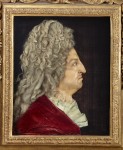 The long, drawn-out, painful death of King Louis XIV of France was thoroughly documented and published in the memoirs of some of the men who witnessed it. It was so slow that the king himself took the opportunity to plan it out thoroughly, concerned about the state of his soul and the future of his realm which he had so materially damaged with endless warfare and extravagant spending. After he finally breathed his last, the elaborate funerary traditions of the monarchy kicked in, and the political ramifications of the succession — Louis outlived his legitimate sons and grandsons leaving his five-year-old great-grandson Louis, Duke of Anjou, as heir to the throne — had to be addressed. The death of any king was of great national and international import; the death of the Sun King more so that most.
The long, drawn-out, painful death of King Louis XIV of France was thoroughly documented and published in the memoirs of some of the men who witnessed it. It was so slow that the king himself took the opportunity to plan it out thoroughly, concerned about the state of his soul and the future of his realm which he had so materially damaged with endless warfare and extravagant spending. After he finally breathed his last, the elaborate funerary traditions of the monarchy kicked in, and the political ramifications of the succession — Louis outlived his legitimate sons and grandsons leaving his five-year-old great-grandson Louis, Duke of Anjou, as heir to the throne — had to be addressed. The death of any king was of great national and international import; the death of the Sun King more so that most.
 The health of Louis XIV had been in decline for the last year of his life. Rumors abounded in the hothouse environment of the royal court at Versailles that his legs were dangerously swollen. In London wagers were laid on how long he would live. Head physician Guy-Crescent Fagon, who despite having basically bled to death Louis’ beloved grandson, granddaughter-in-law and great-grandson when they were struck with measles still held the full confidence of the king and his secret wife Madame de Maintenon, insisted there was nothing seriously wrong with Louis. The king’s head surgeon was not so complacent, but his appeals to Fagon and Mme de Maintenon went unheeded.
The health of Louis XIV had been in decline for the last year of his life. Rumors abounded in the hothouse environment of the royal court at Versailles that his legs were dangerously swollen. In London wagers were laid on how long he would live. Head physician Guy-Crescent Fagon, who despite having basically bled to death Louis’ beloved grandson, granddaughter-in-law and great-grandson when they were struck with measles still held the full confidence of the king and his secret wife Madame de Maintenon, insisted there was nothing seriously wrong with Louis. The king’s head surgeon was not so complacent, but his appeals to Fagon and Mme de Maintenon went unheeded.
 On August 11th, 1715, Louis felt a sudden intense pain in his left leg. Fagon chalked it up to sciatica and prescribed a purgative, but when the pain increased to the point where he couldn’t even walk the short distance to Mme de Maintenon’s chambers, Fagon was finally persuaded to call in consulting physicians. Mareschal was able to assuage the king’s pain by rubbing the leg with hot cloths, but the relief was temporary. The physicians arrived from Paris on August 14th. They felt the king’s pulse and after much discussion prescribed asses’ milk which they then unprescribed because in the hours they spent yammering the king’s pain had abated.
On August 11th, 1715, Louis felt a sudden intense pain in his left leg. Fagon chalked it up to sciatica and prescribed a purgative, but when the pain increased to the point where he couldn’t even walk the short distance to Mme de Maintenon’s chambers, Fagon was finally persuaded to call in consulting physicians. Mareschal was able to assuage the king’s pain by rubbing the leg with hot cloths, but the relief was temporary. The physicians arrived from Paris on August 14th. They felt the king’s pulse and after much discussion prescribed asses’ milk which they then unprescribed because in the hours they spent yammering the king’s pain had abated.
 Mareschal continued to massage the leg because it was the only thing that made him feel better even if just for an hour, and on August 17th he saw that a red spot on the leg had developed into a sore. The surgeon now realized the king had gangrene, that only amputation could save his life. Fagon kept his head firmly embedded in the sand. More doctors’ consultations, more asses’ milk, a bath in spiced Burgundy wine and other useless treatments ensued until the leg’s blackened and swollen condition made it impossible for Fagon to deny that this was a surgeon’s issue and Mareschal took the lead.
Mareschal continued to massage the leg because it was the only thing that made him feel better even if just for an hour, and on August 17th he saw that a red spot on the leg had developed into a sore. The surgeon now realized the king had gangrene, that only amputation could save his life. Fagon kept his head firmly embedded in the sand. More doctors’ consultations, more asses’ milk, a bath in spiced Burgundy wine and other useless treatments ensued until the leg’s blackened and swollen condition made it impossible for Fagon to deny that this was a surgeon’s issue and Mareschal took the lead.
 He had a team of consulting surgeons brought in on August 25th. They took one look at the leg and knew it was just a matter of time. It was too late to amputate. Louis himself realized that he wasn’t bouncing back from this one. He asked Mareschal how long he had left to live and the surgeon told him he had maybe two days. The king began to put his affairs in order. He received the last rites from the Cardinal of Rohan, had the entire court pass before his bed to give their last farewells and brought the young dauphin in to give him the benefit of his final counsel. Reportedly Louis XIV told the soon-to-be Louis XV that he had loved war too much, that it was the ruination of the people, that he should not imitate his taste for expensive construction, that he should spend money alleviating the suffering of his people instead.
He had a team of consulting surgeons brought in on August 25th. They took one look at the leg and knew it was just a matter of time. It was too late to amputate. Louis himself realized that he wasn’t bouncing back from this one. He asked Mareschal how long he had left to live and the surgeon told him he had maybe two days. The king began to put his affairs in order. He received the last rites from the Cardinal of Rohan, had the entire court pass before his bed to give their last farewells and brought the young dauphin in to give him the benefit of his final counsel. Reportedly Louis XIV told the soon-to-be Louis XV that he had loved war too much, that it was the ruination of the people, that he should not imitate his taste for expensive construction, that he should spend money alleviating the suffering of his people instead.
The Sun King died on September 1st, 1715, having reigned 72 years (54 if you subtract the regency) of his 77 years of life.
 The next day his body was autopsied, a long-standing custom for members of the royal family. L’Ouverture (the opening), as the procedure was called, was performed on the state dining table before an array of courtiers and doctors. Mareschal did the honors. From the autopsy report:
The next day his body was autopsied, a long-standing custom for members of the royal family. L’Ouverture (the opening), as the procedure was called, was performed on the state dining table before an array of courtiers and doctors. Mareschal did the honors. From the autopsy report:
The exterior of the left side was found gangrenous from the extremity of the foot to the top of the head; the skin peeling every where, but less on the right than on the left; the body extremely distended and bloated; the bowels much altered with inflammation, especially those on the left side; the large intestines extraordinarily dilated. The kidneys were fairly normal and natural; but in the left one was found a small stone similar to those the King had several times passed without pain while in health. The liver, spleen and stomach were in a normal condition, both externally and internally. The lungs, as well as the chest, normal; the heart in very good condition, of ordinary size; the terminals of the great vessels ossified. All the muscles of the throat gangrenous. On opening the head, the dura mater was found adherent to the cranium, and the pia mater marked with black areas along the falx; the brain sound, in natural condition, outside and within. The interior of the left thigh, where the King’s disease began was completely gangrenous in every part; all the blood in all the vessels totally disorganized, and very scanty in amount.
 The opening concluded, Mareschal embalmed the body. As per a tradition begun with the death of Capetian monarch Philip the Fair in 1314, Louis’ body was divided in three parts, like ancient France had been under Caesar. His viscera were removed and placed in one reliquary, his heart in another and his body in a double coffin of lead and oak. The coffin was displayed for a week in Versailles’ Mercury Room. It left Versailles for Paris the evening of September 8th, arriving at Saint-Denis at dawn the next morning. The coffin was placed in the Bourbon tomb. The entrails were entombed at Notre-Dame. The heart went to the Church of the Jesuits.
The opening concluded, Mareschal embalmed the body. As per a tradition begun with the death of Capetian monarch Philip the Fair in 1314, Louis’ body was divided in three parts, like ancient France had been under Caesar. His viscera were removed and placed in one reliquary, his heart in another and his body in a double coffin of lead and oak. The coffin was displayed for a week in Versailles’ Mercury Room. It left Versailles for Paris the evening of September 8th, arriving at Saint-Denis at dawn the next morning. The coffin was placed in the Bourbon tomb. The entrails were entombed at Notre-Dame. The heart went to the Church of the Jesuits.
 The royal tombs and reliquaries of France were desecrated and destroyed during the French Revolution. Louis XIV’s heart was sold to an artist to use in the production of prized glaze called “mummie” made by macerating an embalmed human heart in alcohol and herbs. The artist, Saint-Martin, kept a chunk of the heart and returned it to the state after the restoration of the monarchy.
The royal tombs and reliquaries of France were desecrated and destroyed during the French Revolution. Louis XIV’s heart was sold to an artist to use in the production of prized glaze called “mummie” made by macerating an embalmed human heart in alcohol and herbs. The artist, Saint-Martin, kept a chunk of the heart and returned it to the state after the restoration of the monarchy.
In honor of the 300th anniversary of Louis XIV’s death, the Palace of Versailles is putting on an exhibition dedicated to his final days, autopsy, funeral and the continuing significance of the ritual in the context of Revolution and Restoration. The King is Dead is the first exhibition dedicated to the monarch’s death.
The exhibition will bring together works of art and historical documents of major importance from the largest French and foreign collections, including ceremonial portraits, funeral statues and effigies, gravestones, the manuscript for the account of the autopsy of the king, coins from the Saint-Denis Treasury, gold medals, emblems and ornaments, and furniture of funeral liturgy. Some of the pieces on display have never been exhibited in public.
Exhibiting these masterpieces has required grand scenography effects. Scenographer Pier Luigi Pizzi was asked by Béatrix Saule, the exhibition’s Head Curator, to design the layout for this great Baroque show. Across the nine sections, visitors will discover a veritable funeral opera conducted by the artist.
[youtube=https://youtu.be/3iDip1GZ7kA&w=430]
Since the dauphin was 5 years old, I wonder how Louis XIV planned to counsel his great grandson to assume power wisely. I would hate spent my last two days on earth counselling the dauphin’s regent instead.
The regent was his nephew Philip II of Orleans who Louis distrusted and disliked. Reportedly the king’s last words to the Duke of Orleans were “You are lucky for you have one king in the tomb and the other in the cradle.” Not exactly a vote of confidence, and Louis’ suspicions were well-founded, as it happened. Orleans broke Louis’ will almost immediately, taking for himself the full regency powers which Louis had willed to his legitimized bastard, the Duke of Maine.
Last rites.
Doh! :thanks:
By the way, it is “last rites” and not “last rights”. Perhaps you ought to correct this little mistake. See https://en.wikipedia.org/wiki/Last_rites
😉
It certainly is and I certainly have. Thank you!
Exactly. 🙂
Curious that the gangrene appears to have begun without a recorded wound in the King’s leg. I wonder if it may have originally actually been sciatica and a bleeding that attempted to relieve the pain actually introduced the deadly infection. Ah, never mind, I’ve googled it and found that it can initiate from diabetes, a condition Louis is suspected to have suffered from. Always learning, with the help of The History Blog 🙂
Apparently it was ischemic gangrene, caused by an arterial clot in the leg. I wasn’t aware of it until I researched this post, but gagrene does not require an infection, just an interruption of the blood supply. When there’s no infection or wound it’s known as dry gangrene.
Fascinating story! A bit stomach-turning but fascinating. Thank you for sharing it! I wanted to tell you that I’ve included your post in my Noteworthy Reads for this week: http://jahcmft.blogspot.com/2015/10/noteworthy-reads-23.html
A little stomach-turning content seemed appropriate considering the day. Thank you kindly for deeming it a notworthy read. :thanks:
Thank you for looking into this. I was left with this question, too!
(Argh, my last was meant to be in reply to the question of what caused the gangrene. The “reply to this comment” bug strikes again!)